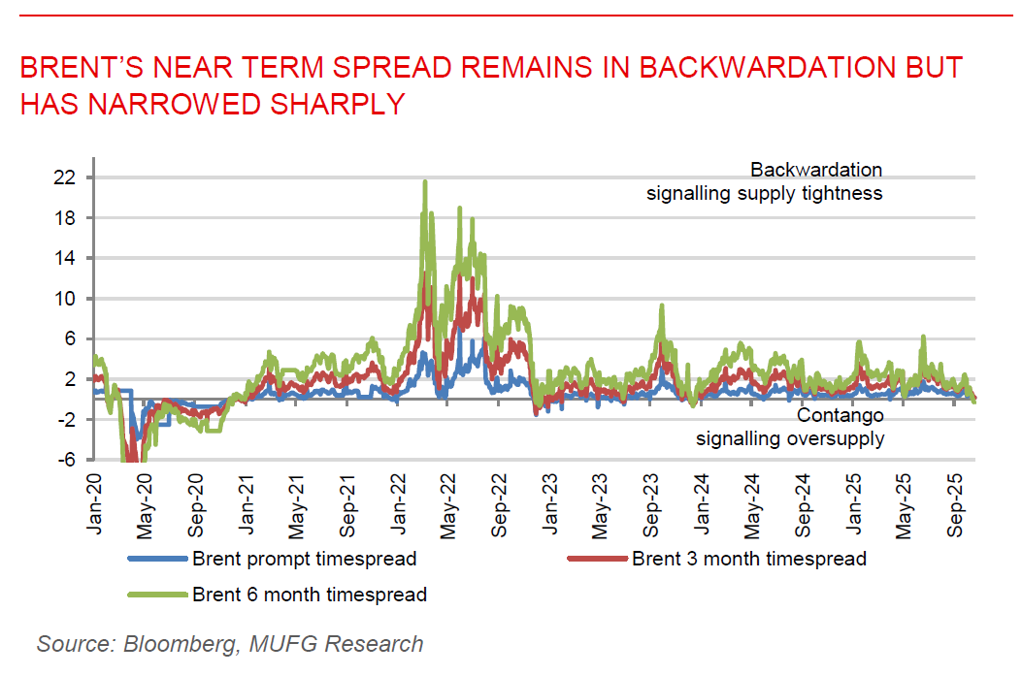To read the full report, please download the PDF above.
Middle East Daily
SOOJIN KIM
Research Analyst
DIFC Branch – Dubai
T: +44(4)387 5031
E: soojin.kim@ae.mufg.jp
MUFG Bank, Ltd. and MUFG Securities plc
A member of MUFG, a global financial group
Middle East Daily
COMMODITIES / ENERGY
Oil prices ease amid trade optimism and oversupply concerns. Oil prices declined after a third consecutive weekly loss, as traders balanced optimism over easing US-China trade tensions with concerns about a growing supply surplus. Brent hovered near USD61/b and WTI around USD57, as upcoming trade talks and President Trump’s remarks about potential tariff relief lifted market sentiment. However, China’s economic slowdown and weak domestic demand weighed on outlook. The International Energy Agency warned that the global oil market faces an even larger surplus into 2026, pressuring prices despite occasional spikes from Ukraine attacks on Russian infrastructure. Market structure signals also point to weakening momentum, Brent’s near term spread remains in backwardation but has narrowed sharply, while longer-dated contracts slipped into bearish contango, underscoring a softening market.
Gold volatile as trade optimism cools haven demand. Gold prices swung between gains and losses after last’s week’s steep sell-off, as easing US-China trade tensions improved market sentiment and reduced safe-haven demand. Technical signals suggest the precious metals rally since August maybe overextended, prompting near-term correction. Investors are watching this week’s US-China trade talks, which could further temper haven flows if tangible progress is made. Still, lingering concerns about credit risks at regional US banks and structural drivers such as central bank buying, ETF inflows, and fiscal imbalances continue to support longer-term demand. Gold has surged more than 60% YTD, marking a ninth consecutive week of gains. Gold’s trajectory will hinge on the balance between easing geopolitical tensions and persistent financial fragilities that sustain investor demand for safe assets.
MIDDLE EAST - CREDIT TRADING
End of day comment – 17 October 2025. With moves in macro markets post London close yesterday, the market opened with a dose of unease. UST yields were 10bp lower and cash prices in bonds unchanged, which made it a bit of scary look if you look at spreads. Once the first trades were done and the mood settled somewhat, the bids stepped up in IG sovgn bonds. That gave some stability to other corners of the market. With higher UST yields and better macro risk sentiment, spreads came in as well by midday and the afternoon remained very quiet and sideways. Sovgn IG closed 2bp wider on average. KSA showed most activity, especially in the 35s conv which closed +0.125pt/+2bp. Long end bonds also remained bid in IG sovgn, but equally with the somewhat sour risk sentiment buyers didn't forced a trade, ADGB 54s closed +0.375pt/+2bp. Higher betas are the laggards today, seen some light selling in OMAN and BHRAIN, BHRAIN long end closed lower in cash, 37s going out -0.125pt/+6bp. Away from sovgn bonds Quasis and fins still see better sellers post new issuance and with cash prices unchanged spreads were 3-5bp wider depending where you look at.
MIDDLE EAST - MACRO / MARKETS
MENA sovereign – resilient but reform-dependent stability. Fitch Rating’s report finds that regional sovereign ratings remain broadly resilient despite ongoing conflicts, underpinned by strong fiscal buffers and structural reform momentum. For the first time since 2019, no sovereign in the region is rated below CCC+ and only Bahrain carries a negative outlook due to persistent fiscal and debt pressures. The average regional rating has slightly improved, with no downgrades since early 2023. Saudi Arabia (A+, Stable) stands out for its fiscal strength and deep reform drive under Vision 2030, though Fitch notes these efforts carry near-term fiscal costs. Oil prices have stayed unexpectedly stable around USD70/b, enabling most GCC states to maintain fiscal surpluses into 2026. Egypt (B, Stable) benefits from recovering domestic demand, while Oman (BB+, Positive) continues to deleverage and strengthen its external position. Fitch concluded that the region’s credit resilience is anchored in reforms, prudent fiscal policy, and ample liquidity, yet warns that an escalation in regional conflict or slower reform progress could test this stability.
Moody’s maintains Israel rating, urges caution over lasting peace prospect. Moody’s Ratings affirmed Israel’s rating, describing the recent Gaza ceasefire as a credit-positive development, while cautioning that the country remains vulnerable to substantial risks. The truce should allow authorities to refocus on fiscal consolidation and economic recovery, but Moody’s emphasised that any material improvement in Israel’s credit profile would require sustained and tangible progress beyond the initial phase. The agency warned that the implementation risks are high, and a breakdown of the deal could trigger renewed conflict. Longer-term credit gains for both Israel and the broader region will depend on regional stability, reconstruction efforts in Gaza, restored trade via the Suez Canal, and eased tensions with Iran. Moody’s now expects Israel’s GDP to grow 2.5% in 2025, rising to 4.5% in 2026, following its September 2024 downgrade to Baa1 due to earlier geopolitical and economic pressure.

